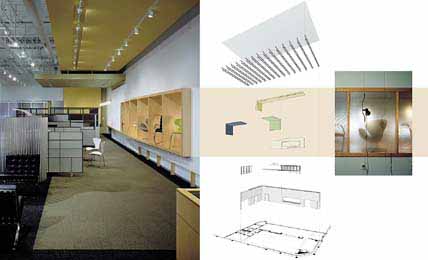
Architects make all the pieces come together, as
in the design elements
for the showroom for Carolina Business interiors, designed by Pearce
Brinkley Cease + Lee
Other related articles:
Freelon Group Captures Firm Award
Annual Awards Celebrate State's Diversity
Wilmington Architect Receives
Gold Medal
Two
Architects Honored for Their Contributions
Putting It All
Together
North Carolina architects ensure
a building's sum is greater than its parts
Whether
your next building project is small or large, you may be certain it
will involve countless complex and complicated decisions. The wrong
choice will cost time and money. You can’t afford mistakes.
“One of the best investments a company or organization can make is
to work with an architect early on in the process. It is helpful to be
involved from the very beginning,” says Bobby Patterson, AIA,
incoming president of the North Carolina Chapter of the American
Institute of Architects.
“Where we can be of greatest value,” the Winston-Salem architect
continues, “is coming together early with a client who knows
everything there is to know about their business. When you add to that
what an architect knows about architecture, planning, site selection
and life and safety issues, the end result is greater than the parts.
“An example is an office building project where the client tells us
everything they need and we meet those needs with the design and
program of the final building. What an architect adds to that process
is creating an environment that not only meets their needs but also
enhances the environment of the people working there. It’s fun to
come to work because the design of the building you work in is
efficient and you feel good being there,” Patterson says.
Working closely with clients and being attentive to their needs leads
to innovative solutions that can make a business more efficient and
functional. “There are situations,” Patterson notes, “where the
building design itself can contribute to the profitability of an
organization. Maybe it’s a manufacturing building where the design
of the building streamlined the manufacturing process.”
Charlotte architect Roy W. Johnson, AIA, current AIA North Carolina
president, agrees that the first and most important step in the
building process is listening to the client. “Listening, learning
about their business, understanding the markets they are in,
recognizing their cost constraints and competitive pressures all takes
place before an architect can begin to think about design.”
Patterson recalls once hearing someone say they would like to be
viewed as an opportunity seeker rather than a problem solver. “A
problem,” he explains, “conveys the sense there is something
wrong. What we try to do when working with a client is to look at the
opportunities and come up with something great in the process.
Architects look for opportunities to enhance what we work on and to
leave it better than we found it.
“A school building is like that,” says Patterson, a principal of
Architectural Design Associates, PLLC. “When you have all the things
that make a school — classrooms, cafeteria, library, gym, offices
— we can create an environment that enhances the process of
education. If children enjoy coming to a school because they like the
way it looks and how it makes them feel, that contributes to the
bottom line we’re looking for.”
Because 85 percent of his firm’s clients are church congregations,
Patterson knows and stresses the importance of developing a master
plan. Churches, as well as businesses, often build in stages.
“Planning is key,” Patterson says. “If you plan a building today
knowing that in the future it will be added on to, the building can be
designed to accept that addition without having to tear things down
later.
“An architect’s work with master planning is vital because an
organization is probably not going to build everything in the
beginning but you want to start somewhere. We can help an organization
meet those needs and decide how the site can best be developed. An
architect with experience about building materials, systems and so
forth can effectively build a good building on a budget and save the
owner money,” Patterson explains.
Guy L. Hipp, a minister at Calvary Baptist Church in Winston-Salem,
has worked with Patterson on several building projects. “Our
architect shows a professionalism in handling problems from design to
construction management. He acts as our agent and ‘mouthpiece’ to
the contractor, subcontractors, and suppliers. His manner lends itself
to build quality friendships in the design team, construction team and
with the building committee. When the projects are complete, the
friendships remain and grow,” Hipp says.
The North Carolina chapter of the American Institute of Architects was
founded in 1913 and is the largest statewide AIA chapter in the nation
with more than 2,000 members. The AIA is the voice of the
architectural profession dedicated to serving its members, advancing
the value of architects to society, and improving the quality of the
built environment.
Return to magazine index
|
|

